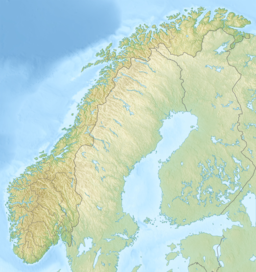| Randsfjorden | |
|---|---|
 Looking south from Grimsrud | |
 | |
| Location | Innlandet and Akershus |
| Coordinates | 60°23′25″N 10°23′39″E / 60.39028°N 10.39417°E |
| Type | glacial fjord lake |
| Primary inflows | Dokka and Etna |
| Primary outflows | Randselva |
| Catchment area | 3,701.54 km2 (1,429.17 sq mi) |
| Basin countries | Norway |
| Max. length | 74.5 km (46.3 mi) |
| Max. width | 4 km (2.5 mi) |
| Surface area | 140.69 km2 (54.32 sq mi) |
| Average depth | 47 m (154 ft) |
| Max. depth | 131 m (430 ft) |
| Water volume | 6.612 km3 (1.586 cu mi) |
| Shore length1 | 203 km (126 mi) |
| Surface elevation | 135 m (443 ft) |
| References | NVE[1] |
| 1 Shore length is not a well-defined measure. | |
Randsfjorden is Norway's fourth-largest lake with an area of 140.7 km2 (54.3 sq mi). Its volume is estimated at just over 6.6 km3 (1.6 cu mi), and its greatest depth is 131 m (430 ft). The lake is located at an elevation of 135 m (443 ft) above sea level. It is located in Innlandet and Akershus counties in the municipalities of Gran, Jevnaker, Nordre Land, and Søndre Land in the districts of Land and Hadeland. It is drained by the Randselva river.
In Heimskringla, Snorri Sturluson recorded that Halfdan the Black (Halvdan Svarte), father of Harald Hårfagre, the first King of Norway, journeyed over the lake while returning home from a visit to Hadeland. Traveling with a horse and sleigh while the lake was supposedly frozen, he fell through the ice and drowned.[2]

In modern times, many golf courses have been set up on the edge of the lake. The Tangen–Horn ferry runs between Horn on the east bank and Tangen on the west, which is Norway's last remaining and regularly operating car ferry connection on an inland lake. The sightseeing boat MS Kong Haud sails on the Randsfjorden from Jevnaker to Odnes.[3]
- ^ "Innsjødatabase". nve.no (in Norwegian). Retrieved 8 October 2022.
- ^ Claus Krag. "Halvdan Svarte". Norsk biografisk leksikon. Retrieved 1 September 2017.
- ^ "MS Kong Haud". hadeland.no. Retrieved 1 September 2017.


